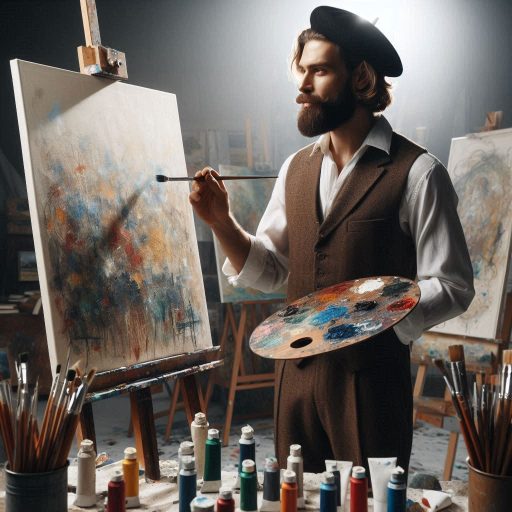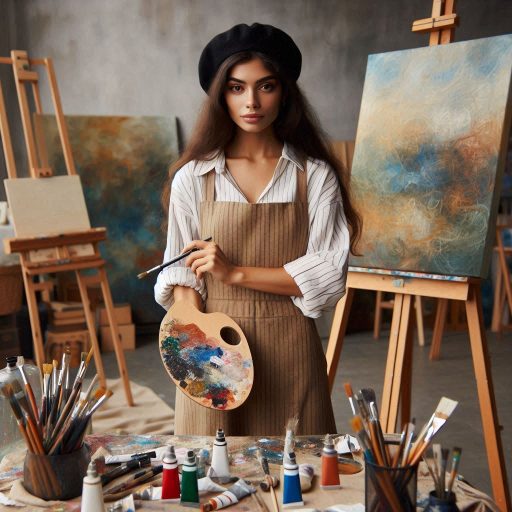Introduction
Choosing the right art and design field is crucial for your career satisfaction and success.
The world of art and design offers vast opportunities, each tailored to different skills, interests, and aspirations.
With the growing demand for creative professionals, a variety of options are available, each offering unique challenges and rewards.
Fields like graphic design, illustration, interior design, fashion design, and multimedia art cater to diverse interests, allowing individuals to explore their creativity in different contexts.
Exploring various fields within art and design not only helps you identify your passion but also allows you to uncover your strengths and talents.
Understanding your interests and skills guides you in making informed decisions about your career path.
Selecting a field that aligns with your personal and professional goals enhances your chances of success and fulfillment.
A well-chosen specialty can lead to exciting projects, collaboration opportunities, and professional growth.
Additionally, your choice of field can significantly impact your job prospects and potential earnings.
For instance, careers in graphic design and digital media are in high demand, often resulting in competitive salaries and job stability.
On the other hand, fields like fashion design may require you to navigate a more volatile market.
Fine Arts
What Fine Arts Entail
Fine arts encompass creative disciplines that focus on visual and aesthetic expression.
This field includes various forms of artistic practice, such as painting, sculpture, and printmaking.
Fine arts prioritize creativity and self-expression over commercial objectives.
Artists create works intended for aesthetic appreciation, often conveying deep emotions or social commentary.
The diverse mediums and techniques used in fine arts enable artists to explore their unique visions and ideas.
Various Career Paths Within Fine Arts
Within fine arts, numerous career paths allow artists to showcase their talents.
One prominent career path is painting.
Painters express their thoughts and emotions through colors, brush strokes, and composition.
They can work in various styles, such as realism, abstract, or impressionism, providing ample opportunities for self-expression.
Another career option is sculpture.
Sculptors create three-dimensional works using materials like clay, metal, and stone.
This medium allows for diverse expressions, from realistic figures to abstract forms.
Sculptors often showcase their work in galleries, public spaces, or installations.
Printmaking also offers a unique career path within fine arts.
Printmakers create images through techniques like etching, lithography, and screen printing.
This process enables them to produce multiple copies of their artwork, making it accessible to a broader audience.
Many printmakers collaborate with artists and galleries to produce limited editions.
Other career paths in fine arts include illustration, photography, and mixed media.
Each discipline requires a unique approach and perspective.
Regardless of the specific path, all artists contribute to the rich tapestry of creative expression.
Skills and Qualities Needed to Succeed in Fine Arts
Succeeding in fine arts requires a blend of skills and personal qualities.
First, strong technical skills are essential.
Artists must understand their chosen medium, including tools, materials, and techniques.
Mastery of these skills enables artists to bring their creative visions to life.
Second, creativity is crucial in fine arts.
Artists must think outside the box and experiment with new ideas.
This creative mindset allows them to develop a unique artistic voice that sets them apart.
Additionally, perseverance plays a vital role in an artist’s journey.
The art world can be competitive and challenging.
Artists must remain dedicated to their craft, continually refining their skills and seeking opportunities for growth.
Therefore, effective communication skills are essential.
Artists must convey their ideas and intentions to audiences, galleries, and potential buyers.
This ability helps them establish connections and build a supportive network within the art community.
Basically, fine arts offers a diverse range of career paths, including painting, sculpture, and printmaking.
Understanding the field and its requirements can help you find your passion.
By developing the necessary skills and qualities, you can thrive in the world of fine arts and make a meaningful impact through your creativity.
Read: Best Tools and Software for Character Designers
Graphic Design
Defining Graphic Design and Its Significance in the Digital Age
Graphic design involves creating visual content to convey messages.
It encompasses everything from logos to websites and marketing materials.
In the digital age, effective graphic design is crucial for capturing audience attention.
It helps brands stand out in a crowded marketplace, fostering engagement and connection.
Graphic designers create visuals that resonate with target audiences.
They use typography, color, and imagery to evoke emotions.
This emotional connection can drive consumer behavior, making graphic design essential for businesses.
As social media and digital marketing grow, so does the demand for skilled graphic designers.
Different Specializations in Graphic Design
Graphic design offers various specializations, each focusing on distinct aspects of visual communication.
Branding involves creating a cohesive identity for a business or product.
This includes designing logos, color schemes, and typography that reflect the brand’s values.
Web design is another key specialization, focusing on creating user-friendly websites.
Designers consider layout, navigation, and overall aesthetics to enhance the user experience.
As online presence becomes increasingly important, web design continues to grow in demand.
Illustration is another specialization within graphic design.
Illustrators create unique visual representations that can enhance storytelling.
Their work often appears in advertising, publishing, and product packaging.
This specialization allows for artistic expression while meeting client needs.
Other specializations include motion graphics, UI/UX design, and print design.
Each specialization requires a unique set of skills and knowledge, catering to different interests and strengths.
Technical Skills Required for a Career in Graphic Design
Pursuing a career in graphic design requires various technical skills.
Proficiency in design software is crucial, including Adobe Creative Suite (Photoshop, Illustrator, and InDesign).
These tools enable designers to create and manipulate visual content effectively.
Understanding design principles is equally important.
Graphic designers should grasp composition, color theory, and typography.
This knowledge helps create visually appealing and effective designs.
Additionally, designers must develop problem-solving skills.
They need to address client needs and create solutions that resonate with audiences.
Effective communication skills are essential for collaborating with clients and team members.
Staying updated on industry trends is vital in graphic design.
Technology and design styles evolve rapidly, so continuous learning is necessary.
Attending workshops, online courses, and industry conferences can enhance skills and knowledge.
In review, graphic design is a dynamic field essential for visual communication in the digital age.
Its various specializations allow designers to find their niche while developing important technical skills.
By exploring these facets, aspiring designers can discover the right path in the vibrant world of graphic design.
Read: Ceramic Art: From Hobby to Professional Career
Fashion Design
The Role of a Fashion Designer
Fashion designers conceptualize and create clothing lines, collections, and accessories.
They research current trends and analyze consumer preferences to inform their designs.
Designers sketch their ideas, often using software to create digital renderings.
They select fabrics, colors, and patterns, ensuring that each piece aligns with their creative vision.
Collaboration is essential for fashion designers.
They work closely with pattern makers, seamstresses, and manufacturers to produce garments.
Designers also coordinate fashion shows, showcasing their collections to potential buyers and the media.
Strong communication skills help designers articulate their ideas and build relationships within the industry.
Paths Within Fashion Design
Fashion design offers various career paths, each with unique focuses.
Apparel design involves creating clothing for various markets, including casual wear, formal attire, and activewear.
Designers in this area must understand fabric properties and garment construction methods.
Accessories design focuses on creating items like bags, shoes, belts, and jewelry.
Accessory designers enhance outfits with their creative flair, considering both functionality and aesthetics.
They often collaborate with apparel designers to ensure a cohesive look across collections.
Costume design is another specialized field within fashion.
Costume designers work in theater, film, and television, creating outfits that reflect character and setting.
This role requires a deep understanding of historical contexts and character development.
Creativity and Dedication in the Fashion Industry
Success in the fashion industry demands immense creativity and dedication.
Designers must constantly innovate and push boundaries to stay relevant.
They need to cultivate a unique style that resonates with their target audience while remaining adaptable to industry changes.
Continuous learning is vital in this fast-paced field.
Fashion trends evolve quickly, requiring designers to stay informed about new materials, techniques, and consumer preferences.
Networking within the industry is also crucial for career growth.
Attending fashion shows, workshops, and events helps designers build connections and gain inspiration.
The fashion industry can be competitive and challenging.
Designers often face criticism and must learn to accept feedback constructively.
Persistence and resilience are key qualities for overcoming obstacles in this dynamic field.
Fashion design offers exciting opportunities for those passionate about creativity and style.
From apparel to accessories and costumes, the field provides diverse career paths.
By embracing creativity and dedication, aspiring fashion designers can carve out their unique place in the industry.
Choosing this vibrant field can lead to a fulfilling and impactful career, shaping the future of fashion.
Read: How to Create Memorable Characters: Pro Tips

Industrial Design
What industrial design involves and its impact on everyday products
Industrial design is a field that involves creating and improving the design and aesthetics of everyday products that are manufactured for mass production.
It plays a crucial role in shaping the way we interact with these products on a daily basis.
From the smartphone you use to the chair you sit on, industrial design is everywhere.
Subfields of Industrial Design
Product Design
This subfield focuses on the design of consumer products such as electronics, appliances, and household items.
Product designers aim to create functional and aesthetically pleasing products that enhance the user experience.
Furniture Design
Furniture designers specialize in creating furniture pieces that are not only visually appealing but also ergonomically sound and durable.
They take into account factors such as materials, construction techniques, and user comfort.
Toy Design
Toy designers are responsible for developing toys that entertain, educate, and engage children of various ages.
They need to consider safety regulations, age-appropriate designs, and play value when creating new toy concepts.
Transform Your Career Today
Unlock a personalized career strategy that drives real results. Get tailored advice and a roadmap designed just for you.
Start NowSkills for Success in Industrial Design
Success in industrial design requires a unique combination of technical skills, creativity, and problem-solving abilities.
Here are some key skills that are necessary for anyone pursuing a career in this field
Sketching and Drawing
Being able to quickly sketch out ideas and concepts is essential in the design process.
This skill helps designers communicate their vision effectively to clients and collaborators.
3D Modeling
Proficiency in 3D modeling software is crucial for creating detailed and realistic digital prototypes of product designs.
This skill allows designers to visualize their concepts in a three-dimensional space.
Prototyping
The ability to create physical prototypes of designs using various materials and tools is essential for testing and refining product concepts.
Prototyping helps designers evaluate the functionality and usability of their designs before mass production.
User-Centered Design
Understanding the needs and preferences of end-users is fundamental in industrial design.
Designers must conduct research, gather feedback, and test their products with target users to ensure that the final design meets their requirements.
Creative Problem-Solving
Industrial designers often face challenges and constraints when developing new products.
The ability to think creatively, identify solutions, and adapt to changing requirements is critical for overcoming obstacles and delivering innovative designs.
By honing these skills and staying abreast of industry trends and technologies, aspiring industrial designers can position themselves for success in a dynamic and rewarding field that has a significant impact on the products we use in our daily lives.
Read: Ceramic Art Exhibitions to Visit in 2024
Interior Design
Defining Interior Design and Its Importance
Interior design is the art of enhancing interior spaces.
It involves planning and designing the layout, furnishings, and decor of a space.
A well-designed interior improves functionality and enhances the user experience.
Designers consider various factors, including color, light, texture, and space utilization.
Creating a harmonious and visually appealing environment is essential.
Well-designed spaces can influence mood, productivity, and overall well-being.
For example, bright colors can energize a room, while soft hues promote relaxation.
Thoughtful design choices impact how people interact with their environment.
Areas of Specialization in Interior Design
Interior design encompasses several areas of specialization, allowing designers to focus on specific aspects of the field.
Residential design involves creating comfortable living spaces for individuals and families.
Designers work closely with clients to understand their needs and preferences.
They create tailored solutions that reflect the client’s personality and lifestyle.
Commercial design focuses on public spaces like offices, retail stores, and restaurants.
Designers must consider functionality and branding in these environments.
They create spaces that enhance the user experience while promoting the business’s goals.
Sustainable design has gained popularity in recent years.
This specialization emphasizes eco-friendly practices and materials.
Designers consider energy efficiency, waste reduction, and the use of sustainable materials.
By prioritizing sustainability, interior designers contribute to a healthier planet.
Creative and Practical Skills Needed
To thrive as an interior designer, individuals must possess a unique blend of creative and practical skills.
Creativity is essential for developing innovative design concepts.
Designers must visualize spaces and think outside the box to create stunning interiors.
Technical skills are equally important.
Designers need to understand architectural principles and spatial planning.
Proficiency in design software, such as AutoCAD and SketchUp, is crucial for creating detailed plans.
Additionally, knowledge of building codes and regulations ensures compliance with safety standards.
Communication skills play a significant role in interior design.
Designers must effectively convey their ideas to clients, contractors, and suppliers.
Strong interpersonal skills help build relationships and foster collaboration within the industry.
Finally, project management skills are vital for overseeing design projects from conception to completion.
Designers must manage budgets, timelines, and resources efficiently.
This ensures that projects are completed on schedule and within budget.
In essence, interior design is a dynamic field that combines creativity and functionality.
Its importance in creating visually appealing and practical spaces cannot be overstated.
With various specializations and essential skills, aspiring interior designers can find their niche in this exciting industry.
Whether focusing on residential, commercial, or sustainable design, the possibilities for creativity and impact are endless.
Animation
Introduce the Field of Animation and Its Applications in Various Industries
Animation plays a crucial role in entertainment and education.
In film and television, animated characters bring stories to life.
This medium engages viewers of all ages, creating memorable experiences.
Video games also rely heavily on animation, providing immersive environments and realistic character movements.
Moreover, animation enhances advertising and marketing efforts.
Brands use animated content to capture attention and communicate messages effectively.
Educational institutions utilize animation to simplify complex concepts, making learning more accessible.
This versatility makes animation a valuable skill in many sectors.
Explore the Different Types of Animation
Several types of animation exist, each with unique techniques and applications.
2D animation involves creating movement in a two-dimensional space.
Traditional hand-drawn animation is a classic example, while digital 2D animation utilizes software for efficiency.
This style is commonly used in cartoons, mobile apps, and online videos.
3D animation adds depth and realism to the visuals.
This technique uses computer-generated imagery (CGI) to create three-dimensional characters and environments.
3D animation dominates the film industry, especially for blockbuster movies and video games.
It offers animators more freedom to explore complex designs and movements.
Stop motion animation involves photographing physical objects frame by frame.
This technique creates the illusion of movement by slightly repositioning the objects between shots.
Stop motion often appears in independent films and children’s programming, showcasing a unique artistic approach.
Each type of animation serves distinct purposes and appeals to different audiences.
Talk About the Technical Skills and Creativity Required for a Career in Animation
A successful career in animation requires a blend of technical skills and creativity.
Animators must be proficient in various software tools, including Adobe Animate, Maya, and Blender.
Understanding principles like timing, movement, and storytelling is essential for creating engaging animations.
Creativity plays a vital role in bringing ideas to life.
Animators need to visualize characters, environments, and narratives effectively.
They must think critically and solve problems, as animations often evolve during the creative process.
Strong drawing skills and an eye for detail are also beneficial.
Collaboration is key in the animation industry.
Animators often work with directors, writers, and other artists.
Effective communication and teamwork skills contribute to the success of a project.
Generally, animation is a dynamic field with diverse applications across industries.
Understanding the different types of animation helps aspiring animators choose their path.
Technical skills and creativity are essential for success in this vibrant industry.
If you have a passion for storytelling and visual art, a career in animation may be the perfect fit for you.
Conclusion
Exploring various art and design fields reveals a wealth of unique opportunities and challenges.
Throughout this blog, we discussed key areas, including graphic design, fashion design, interior design, and industrial design.
Each field offers distinct career paths, requiring specific skills, education, and passions that cater to different interests and strengths.
Understanding these differences is essential for making an informed choice that aligns with your creative aspirations.
Choosing the right art and design field is crucial for personal fulfillment and career success.
Aligning your interests with your professional goals not only enhances your motivation but also ensures long-term satisfaction in your career.
Consider your strengths, weaknesses, and the aspects of art and design that resonate with you most deeply.
Reflecting on these elements will guide your decision-making process and help you find the right fit.
We encourage readers to conduct further research on their preferred fields.
Investigating industry trends, job prospects, and educational requirements can provide valuable insights into what to expect.
Familiarize yourself with the daily responsibilities of professionals in each field to better understand what a career might entail.




